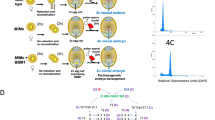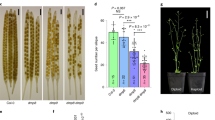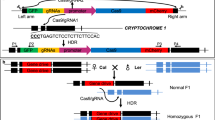Abstract
Apomixis, the formation of asexual seeds in plants, leads to populations that are genetically uniform maternal clones. The transfer of apomixis to crop plants holds great promise in plant breeding for fixation of heterozygosity and hybrid vigour because it would allow the propagation of hybrids over successive generations1,2. Apomixis involves the production of unreduced (diploid) female gametes that retain the genotype of the parent plant (apomeiosis), followed by parthenogenetic development of the egg cell into an embryo and the formation of functional endosperm3. The molecular mechanisms underlying apomixis are unknown. Here we show that mutation of the Arabidopsis gene DYAD/SWITCH1 (SWI1)4,5, a regulator of meiotic chromosome organization, leads to apomeiosis. We found that most fertile ovules in dyad plants form seeds that are triploid and that arise from the fertilization of an unreduced female gamete by a haploid male gamete. The unreduced female gametes fully retain parental heterozygosity across the genome, which is characteristic of apomeiosis. Our results show that the alteration of a single gene in a sexual plant can bring about functional apomeiosis, a major component of apomixis.
This is a preview of subscription content, access via your institution
Access options
Subscribe to this journal
Receive 51 print issues and online access
$199.00 per year
only $3.90 per issue
Buy this article
- Purchase on Springer Link
- Instant access to full article PDF
Prices may be subject to local taxes which are calculated during checkout



Similar content being viewed by others
References
Koltunow, A. M., Bicknell, R. A. & Chaudhury, A. M. Apomixis: molecular strategies for the generation of genetically identical seeds without fertilization. Plant Physiol. 108, 1345–1352 (1995)
Spillane, C., Steimer, A. & Grossniklaus, U. Apomixis in agriculture: the quest for clonal seeds. Sex. Plant Reprod. 14, 179–187 (2001)
Koltunow, A. M. & Grossniklaus, U. Apomixis: a developmental perspective. Annu. Rev. Plant Biol. 54, 547–574 (2003)
Mercier, R. et al. SWITCH1 (SWI1): a novel protein required for the establishment of sister chromatid cohesion and for bivalent formation at meiosis. Genes Dev. 15, 1859–1871 (2001)
Agashe, B., Prasad, C. K. & Siddiqi, I. Identification and analysis of DYAD: a gene required for meiotic chromosome organisation and female meiotic progression in Arabidopsis. Development 129, 3935–3943 (2002)
Mogie, M. A model for the evolution and control of generative apomixis. Biol. J. Linn. Soc. 35, 127–154 (1988)
Siddiqi, I., Ganesh, G., Grossniklaus, U. & Subbiah, V. The dyad gene is required for progression through female meiosis in Arabidopsis. Development 127, 197–207 (2000)
Altmann, T. et al. Easy determination of ploidy level in Arabidopsis thaliana plants by means of pollen size measurement. Plant Cell Rep. 13, 652–666 (1994)
Dilkes, B. P. & Comai, L. A. Differential dosage hypothesis for parental effects in seed development. Plant Cell 16, 3174–3180 (2004)
Spielman, M., Vinkenoog, R., Dickinson, H. G. & Scott, R. J. The epigenetic basis of gender in flowering plants and mammals. Trends Genet. 17, 705–711 (2001)
Bretagnolle, F. & Thompson, J. D. Gametes with the somatic chromosome number: mechanisms of their formation and role in the evolution of autopolyploid plants. New Phytol. 129, 1–22 (1995)
Rhoades, M. M. & Dempsey, E. Induction of chromosome doubling at meiosis by the elongate gene in maize. Genetics 54, 505–522 (1966)
Finch, R. A. & Bennet, M. D. Action of triploid inducer (tri) on meiosis in barley (Hordeum vulgare L.). Hereditas 43, 87–93 (1979)
Curtis, C. A. & Doyle, D. G. Production of aneuploid and diploid eggs by meiotic mutants of maize. J. Hered. 83, 335–341 (1992)
Douches, D. S. & Quiros, C. F. Genetic strategies to determine the mode of 2n egg formation in diploid potatoes. Euphytica 38, 247–260 (1988)
Barone, A., Gebhardt, C. & Frusciante, L. Heterozygosity in 2n gametes of potato evaluated by RFLP markers. Theor. Appl. Genet. 91, 98–104 (1995)
Vorsa, L. & Rowland, L. J. Estimation of 2n megagametophyte heterozygosity in a diploid Blueberry (Vaccinium darrowi Camp) clone using RAPDs. J. Hered. 8, 423–426 (1997)
Noyes, R. D. Inheritance of apomeiosis (diplospory) in fleabanes (Erigeron, Asteraceae). Heredity 94, 193–198 (2005)
Savidan, Y. H. Apomixis: genetics and breeding. Plant Breed. Rev. 18, 13–86 (2000)
Huanca-Mamani, W., Garcia-Aguilar, M., Leon-Martinez, G., Grossniklaus, U. & Vielle-Calzada, J. P. CHR11, a chromatin-remodeling factor essential for nuclear proliferation during female gametogenesis in Arabidopsis thaliana. Proc. Natl Acad. Sci. USA 102, 17231–17236 (2005)
Blakey, C. A., Goldman, S. L. & Dewald, C. L. Apomixis in Tripsacum: Comparative mapping of a multigene phenomenon. Genome 44, 222–230 (2001)
Hamant, O., Ma, H. & Cande, W. Z. Genetics of meiotic prophase I in plants. Annu. Rev. Plant Biol. 57, 267–302 (2006)
Chen, K. Y., Cong, B., Wing, R., Vrebalov, J. & Tanksley, S. D. Changes in regulation of a transcription factor lead to autogamy in cultivated tomatoes. Science 318, 643–645 (2007)
Ozias-Akins, P., Roche, D. & Hanna, W. W. Tight clustering and hemizygosity of apomixis-linked molecular markers in Pennisetum squamulatum implies genetic control of apospory by a divergent locus that may have no allelic form in sexual genotypes. Proc. Natl Acad. Sci. USA 95, 5127–5132 (1998)
Pessino, S. C. et al. A genetic map of the apospory-region in Brachiaria hybrids: Identification of two markers closely associated with the trait. Hereditas 128, 153–158 (1998)
Grimanelli, D. et al. Mapping diplosporous apomixis in tetraploid Tripsacum: one gene or several genes? Heredity 80, 33–39 (1998)
Pupilli, F. et al. Comparative mapping reveals partial conservation of synteny at the apomixis locus in Paspalum spp. Mol. Genet. Genomics 270, 539–548 (2004)
Guitton, A. E. & Berger, F. Loss of function MULTICOPY SUPPRESSOR OF IRA1 produces nonviable parthenogenetic embryos in Arabidopsis.. Curr. Biol. 15, 750–754 (2005)
Sundaresan, V. et al. Patterns of gene action in plant development revealed by enhancer trap and gene trap transposable elements. Genes Dev. 9, 1797–1810 (1995)
Ross, K. J., Fransz, P. & Jones, G. H. A light microscopic atlas of meiosis in Arabidopsis thaliana. Chromosome Res. 4, 507–516 (1996)
Dellaporta, S. L., Wood, J. & Hicks, J. B. A plant DNA minpreparation: version II. Plant Mol. Biol. Rep. 1, 19–21 (1983)
Alexander, M. P. Differential staining of aborted and nonaborted pollen. Stain Technol. 44, 117–122 (1969)
Bechtold, N., Ellis, J. & Pelletier, G. In planta Agrobacterium-mediated gene transfer by infiltration of adult Arabidopsis thaliana plants. C. R. Acad. Sci. Life Sci. 316, 1194–1199 (1993)
Acknowledgements
We thank V. Vijaybhaskar and V. Subbiah for characterization of the ET60 transposon line; S. Andreuzza, J. Dhawan, S. Mayor, B. Nishal, M. Ramaswami, A. Ray and O. Siddiqi for comments on the manuscript; and the ABRC for seeds. This work was supported by the Council for Scientific and Industrial Research (CSIR; Government of India), and a Centre of Excellence grant from the Department of Biotechnology (to I.S.). M.R. and M.M. were supported by fellowships from the University Grants Commission and the CSIR, respectively.
Author Contributions M.P.M. conducted the experiments on marker gene expression and interpreted the results. M.R. and I.S. planned, and M.R. performed, the remaining experiments and interpreted the results. I.S. wrote the paper with input from M.R.
Author information
Authors and Affiliations
Corresponding author
Supplementary information
Supplementary Information
This file contains: Supplementary Figure 1 detailing mutant alleles and phenotypes for SWI1; Supplementary Figure 2 showing variation in pollen size; and Supplementary Note 1 showing estimation of triploid formation in dyad versus wild type. (PDF 1167 kb)
Rights and permissions
About this article
Cite this article
Ravi, M., Marimuthu, M. & Siddiqi, I. Gamete formation without meiosis in Arabidopsis. Nature 451, 1121–1124 (2008). https://doi.org/10.1038/nature06557
Received:
Accepted:
Published:
Issue Date:
DOI: https://doi.org/10.1038/nature06557
This article is cited by
-
Engineering apomixis in crops
Theoretical and Applied Genetics (2023)
-
Apomixis: oh, what a tangled web we have!
Planta (2023)
-
Female meiosis in plants, and differential recombination in the two sexes: a perspective
The Nucleus (2023)
-
Apomixis: A Foresight from Genetic Mechanisms to Molecular Perspectives
The Botanical Review (2022)
-
SWITCH 1/DYAD is a WINGS APART-LIKE antagonist that maintains sister chromatid cohesion in meiosis
Nature Communications (2019)
Comments
By submitting a comment you agree to abide by our Terms and Community Guidelines. If you find something abusive or that does not comply with our terms or guidelines please flag it as inappropriate.



